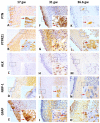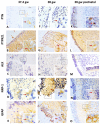Pleiotrophin and the Expression of Its Receptors during Development of the Human Cerebellar Cortex
- PMID: 37443767
- PMCID: PMC10341181
- DOI: 10.3390/cells12131733
Pleiotrophin and the Expression of Its Receptors during Development of the Human Cerebellar Cortex
Abstract
During embryonic and fetal development, the cerebellum undergoes several histological changes that require a specific microenvironment. Pleiotrophin (PTN) has been related to cerebral and cerebellar cortex ontogenesis in different species. PTN signaling includes PTPRZ1, ALK, and NRP-1 receptors, which are implicated in cell differentiation, migration, and proliferation. However, its involvement in human cerebellar development has not been described so far. Therefore, we investigated whether PTN and its receptors were expressed in the human cerebellar cortex during fetal and early neonatal development. The expression profile of PTN and its receptors was analyzed using an immunohistochemical method. PTN, PTPRZ1, and NRP-1 were expressed from week 17 to the postnatal stage, with variable expression among granule cell precursors, glial cells, and Purkinje cells. ALK was only expressed during week 31. These results suggest that, in the fetal and neonatal human cerebellum, PTN is involved in cell communication through granule cell precursors, Bergmann glia, and Purkinje cells via PTPRZ1, NRP-1, and ALK signaling. This communication could be involved in cell proliferation and cellular migration. Overall, the present study represents the first characterization of PTN, PTPRZ1, ALK, and NRP-1 expression in human tissues, suggesting their involvement in cerebellar cortex development.
Keywords: ALK; NRP-1; RPTPZ1; cerebellum; development; human; pleiotrophin.
Conflict of interest statement
The authors declare no conflict of interest.
Figures




References
Publication types
MeSH terms
Substances
Grants and funding
LinkOut - more resources
Full Text Sources
Miscellaneous

